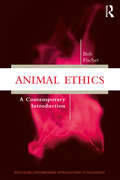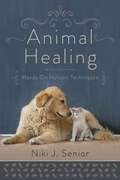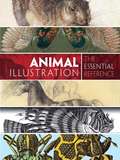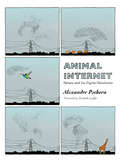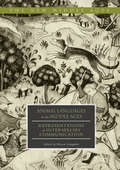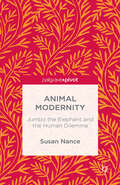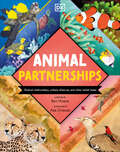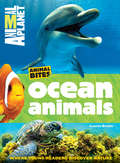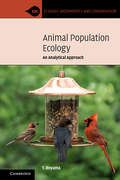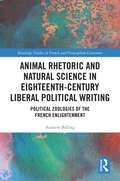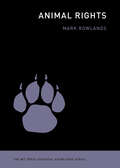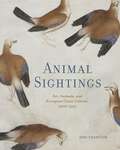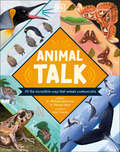- Table View
- List View
Animal Ethics: A Contemporary Introduction (Routledge Contemporary Introductions to Philosophy)
by Bob FischerThere are many introductions to the animal ethics literature. There aren’t many introductions to the practice of doing animal ethics. Bob Fischer’s Animal Ethics: A Contemporary Introduction fills that gap, offering an accessible model of how animal ethics can be done today. The book takes up classic issues, such as the ethics of eating meat and experimenting on animals, but tackles them in an empirically informed and nuanced way. It also covers a range of relatively neglected issues in animal ethics, such as the possibility of insect sentience and the ethics of dealing with pests. Finally, the book doesn’t assess every current practice using standard ethical theories, but tries to evaluate some of them using the moral frameworks endorsed by those involved. So, for instance, there is a chapter on the way that animal care and use committees try to justify some of the educational uses of animals, and the chapter on zoos considers the way that international zoological societies justify compromising animal welfare. The book wraps up with a discussion of the future of animal ethics. Each chapter opens with a helpful initial overview of the chapter and ends with a list of suggested readings to help students go further on their own. Key Features Covers animal ethics from an empirically informed perspective, bringing philosophy into conversation with key issues in animal science, conservation biology, economics, ethology, and legal studies, among other fields Provides ample coverage of the most salient current topics, including, for example: Debates about which animals are sentient The suffering of wild animals Research ethics The boundaries of activism Avoids suggesting that animal ethics is simply the practice of applying the right general theory to a problem, instead allowing readers to first work out the specific costs and benefits of making ethical decisions Impresses upon the reader the need for her to work out for herself the best way forward with difficult ethical issues, suggesting that progress can indeed be made Includes summaries and recommended readings at the end of each chapter
Animal Factory: The Looming Threat of Industrial Pig, Dairy, and Poultry Farms to Humans and the Environment
by David KirbySwine flu. Bird flu. Unusual concentrations of cancer and other diseases. Massive fish kills from flesh-eating parasites. Recalls of meats, vegetables, and fruits because of deadly E-coli bacterial contamination. Recent public health crises raise urgent questions about how our animal-derived food is raised and brought to market. In Animal Factory, bestselling investigative journalist David Kirby exposes the powerful business and political interests behind large-scale factory farms, and tracks the far-reaching fallout that contaminates our air, land, water, and food. In this thoroughly researched book, Kirby follows three families and communities whose lives are utterly changed by immense neighboring animal farms. These farms (known as "Concentrated Animal Feeding Operations," or CAFOs), confine thousands of pigs, dairy cattle, and poultry in small spaces, often under horrifying conditions, and generate enormous volumes of fecal and biological waste as well as other toxins. Weaving science, politics, law, big business, and everyday life, Kirby accompanies these families in their struggles against animal factories. A North Carolina fisherman takes on pig farms upstream to preserve his river, his family's life, and his home. A mother in a small Illinois town pushes back against an outsized dairy farm and its devastating impact. And a Washington State grandmother becomes an unlikely activist when her home is invaded by foul odors and her water supply is compromised by runoff from leaking lagoons of cattle waste. Animal Factory is an important book about our American food system gone terribly wrong---and the people who are fighting to restore sustainable farming practices and save our limited natural resources.
Animal Firefighters to the Rescue
by Sonja ColeClimate change affects many regions with hotter and drier weather, and forest fires are a growing problem. Learn how hungry animals might help reduce wildfires. Fires need fuel, oxygen and heat to start a flame. The forest floors are covered with dry grass, dead wood, and bark called duff–fire fuel! Learn how conservationists are using sheep, goats, beavers and other animals to reduce fires!
Animal Healing: Hands-On Holistic Techniques
by Niki J. SeniorUse Powerful Natural Techniques to Heal and Communicate with Your AnimalsEnhance the health and happiness of your beloved companions with this comprehensive guide to holistic healing and therapy modalities. Animal Healing demystifies vibrational energy and offers detailed information on how you can sense, establish, and attune your awareness to animal energy. You'll learn to activate wellness on all levels and deepen the unbreakable bond with your animal's heart, mind, and soul.Providing in-depth descriptions and case studies that illustrate the healing modalities, Niki J. Senior sheds light on the true nature of animal health and disease. Through ground-breaking methods and exercises, she helps you use gemstones, crystals, flower essences, and other natural remedies to effectively heal your animal.Praise:"As a professional vet, I found this book an enlightening approach to holistic animal health and understand how complementary and veterinary methods can work in synergy."—Bernd Wittorf, MRCVS, veterinarian, Freie Universität Berlin"[Animal Healing includes] a combination of anecdotes, success stories, personal battles, science, therapies, how-to instruction, and self-care . . . by the time you have finished, your love for your animal, yourself, and for all of life will have reached new vibrations, new connections, and higher energies—you will already be healing your animal before you know it!"—Isla Fishburn, PhD, founder of Kachina Canine
Animal Illustration: The Essential Reference
by Carol Belanger GraftonComprehensive and entertaining, this volume comprises the greatest works in animal illustration from the Middle Ages through the twentieth century. The chronological presentation of hundreds of black-and-white and color images begins with a medieval illuminated manuscript by the Limbourg brothers and the Renaissance works of Albrecht Dürer and other artists from the first centuries of printing. Subsequent illustrations include the seventeenth-century real and imaginary animals of Matthäus Merian and the unique eighteenth-century compilations of Albertus Seba. Nineteenth-century images are drawn from sources as diverse as J. G. Heck's Bilder Atlas; the prints of Georges Baron Cuvier; William Jardine's 40-volume Naturalist's Library; bird illustrations by John James Audubon, Alexander Wilson, Edward Lear, and many others; extraordinary butterfly and insect images by E. A. Seguy, as well as animal illustrations from Victorian chromolithograph die cuts. The exquisite Edwardian bestiary of the Detmold brothers brings the collection into the twentieth century, and ends with the imagery of contemporary dinosaur artist James Gurney.Detailed bibliographical information concerning every source—including biographical details of each artist—makes this collection a vital reference tool as well as a splendid resource of outstanding animal illustrations. Students of graphic art and illustration, as well as graphic designers and advertising professionals, will prize this treasury of material from many rare historic sources.
Animal Internet: Nature and the Digital Revolution
by Alexander Pschera Elisabeth Lauffer"Animal Internet is a most important book. This excellent work could be a strong catalyst for people to rewild, to reconnect and become re-enchanted with all sorts of mysterious and fascinating animals, both local and distant. By shrinking the world it will bring humans and other animals together in a multitude of ways that only a few years ago were unimaginable."--Marc Bekoff, University of Colorado, author of Rewilding Our Hearts: Building Pathways of Compassion and Coexistence "An original book that goes against the trend to stubbornly keep nature and technology divided from one another."--Der Spiegel "Animal Internet is one of the most interesting books that I've read in recent years."--Bavarian Radio"What Pschera describes sounds futuristic but it's already widespread reality . . . Pschera's book is not just popular science: he describes not only the status quo, but also thinks about an ongoing transformation."--Wired.deSome fifty thousand creatures around the globe--including whales, leopards, flamingoes, bats, and snails--are being equipped with digital tracking devices. The data gathered and studied by major scientific institutes about their behavior will warn us about tsunamis, earthquakes and volcanic eruptions, but also radically transform our relationship to the natural world. With a broad cultural and historical perspective, this book examines human ties with animals, from domestic pets to the soaring popularity of bird watching and kitten images on the web. Will millennia of exploration soon be reduced to experiencing wilderness via smartphone? Contrary to pessimistic fears, author Alexander Pschera sees the Internet as creating a historic opportunity for a new dialogue between man and nature.Foreword by Martin Wikelski, Director, Max Planck Institute for OrnithologyAlexander Pschera, born in 1964, has published several books on the internet and media. He studied German, music, and philosophy at Heidelberg University. He lives near Munich where he writes for the German magazine Cicero as well as for German radio.
Animal Languages in the Middle Ages: Representations of Interspecies Communication (The New Middle Ages)
by Alison LangdonThe essays in this interdisciplinary volume explore language, broadly construed, as part of the continued interrogation of the boundaries of human and nonhuman animals in the Middle Ages. Uniting a diverse set of emerging and established scholars, Animal Languages questions the assumed medieval distinction between humans and other animals. The chapters point to the wealth of non-human communicative and discursive forms through which animals function both as vehicles for human meaning and as agents of their own, demonstrating the significance of human and non-human interaction in medieval texts, particularly for engaging with the Other. The book ultimately considers the ramifications of deconstructing the medieval anthropocentric view of language for the broader question of human singularity.
Animal Liberation Now: The Definitive Classic Renewed
by Peter SingerTHE UPDATED CLASSIC OF THE ANIMAL RIGHTS MOVEMENT, NOW WITH AN INTRODUCTION BY YUVAL NOAH HARARI Few books maintain their relevance—and have remained continuously in print—nearly fifty years after they were first published. Animal Liberation, one of TIME’s “All-TIME 100 Best Nonfiction Books” is one such book. Since its original publication in 1975, this groundbreaking work has awakened millions of people to the existence of "speciesism"—our systematic disregard of nonhuman animals—inspiring a worldwide movement to transform our attitudes to animals and eliminate the cruelty we inflict on them. In Animal Liberation Now, Singer exposes the chilling realities of today's "factory farms" and product-testing procedures, destroying the spurious justifications behind them and showing us just how woefully we have been misled. Now, Singer returns to the major arguments and examples and brings us to the current moment. This edition, revised from top to bottom, covers important reforms in the European Union and in various U.S. states, but on the flip side, Singer shows us the impact of the huge expansion of factory farming due to the exploding demand for animal products in China. Further, meat consumption is taking a toll on the environment, and factory farms pose a profound risk for spreading new viruses even worse than COVID-19. Animal Liberation Now includes alternatives to what has become a profound environmental and social as well as moral issue. An important and persuasive appeal to conscience, fairness, decency, and justice, it is essential reading for the supporter and the skeptic alike.
Animal Modernity: Jumbo The Elephant And The Human Dilemma
by Susan NanceThe concept of 'modernity' is central to many disciplines, but what is modernity to animals? Susan Nance answers this question through a radical reinterpretation of the life of Jumbo the elephant. In the 1880s, consumers, the media, zoos, circuses and taxidermists, and (unknowingly) Jumbo himself, transformed the elephant from an orphan of the global ivory trade and zoo captive into a distracting international celebrity. Citizens on two continents imaged Jumbo as a sentient individual and pet, but were aghast when he died in an industrial accident and his remains were absorbed by the taxidermic and animal rendering industries reserved for anonymous animals. The case of Jumbo exposed the 'human dilemma' of modern living, wherein people celebrated individual animals to cope or distract themselves from the wholesale slaughter of animals required by modern consumerism.
Animal Movement: Statistical Models for Telemetry Data
by Juan M. Morales Mevin B. Hooten Devin S. Johnson Brett T. McClintockThe study of animal movement has always been a key element in ecological science, because it is inherently linked to critical processes that scale from individuals to populations and communities to ecosystems. Rapid improvements in biotelemetry data collection and processing technology have given rise to a variety of statistical methods for characterizing animal movement. The book serves as a comprehensive reference for the types of statistical models used to study individual-based animal movement. Animal Movement is an essential reference for wildlife biologists, quantitative ecologists, and statisticians who seek a deeper understanding of modern animal movement models. A wide variety of modeling approaches are reconciled in the book using a consistent notation. Models are organized into groups based on how they treat the underlying spatio-temporal process of movement. Connections among approaches are highlighted to allow the reader to form a broader view of animal movement analysis and its associations with traditional spatial and temporal statistical modeling. After an initial overview examining the role that animal movement plays in ecology, a primer on spatial and temporal statistics provides a solid foundation for the remainder of the book. Each subsequent chapter outlines a fundamental type of statistical model utilized in the contemporary analysis of telemetry data for animal movement inference. Descriptions begin with basic traditional forms and sequentially build up to general classes of models in each category. Important background and technical details for each class of model are provided, including spatial point process models, discrete-time dynamic models, and continuous-time stochastic process models. The book also covers the essential elements for how to accommodate multiple sources of uncertainty, such as location error and latent behavior states. In addition to thorough descriptions of animal movement models, differences and connections are also emphasized to provide a broader perspective of approaches.
Animal Partnerships: Radical Relationships, Unlikely Alliances, and Other Animal Teams (Wonders of Wildlife )
by Ben HoareDiscover a whole host of partnerships from across the animal kingdom, with the nature enthusiast and best-selling author Ben Hoare.Get acquainted with unexpected animal teams around the world, and find out how these groups thrive in the wild as they defend, feed, and plot with each other in order to survive in this fascinating and unique look at animals.Presenting these unpredictable discoveries, Ben Hoare's friendly, informative explanations are paired with striking photographs and colorful illustrations to make sure every page captivates the imagination. This unique animal book for children offers: Groundbreaking scientific discoveries, including animal behaviors that have only just been documented.Impressive facts about previously unknown animal behaviors that are guaranteed to wow adults and children alike.Animals shown in incredible detail through photographs paired with charming illustration.Animal Partnerships explores cooperative relationships between sea turtles at underwater "cleaning stations" ran by surgeon fish, “bands of brothers” within particular species of big cats, and even cross-species alliances between birds and dolphins that are hungry for a shared meal. Discover how animals and plants depend upon each other to hold their territory, and how even humans have come to develop partnerships with animals all around the world.
Animal Physiology
by Margaret Anderson Richard W. Hill Gordon A. WyseAnimal Physiology presents all the branches of modern animal physiology with a strong emphasis on integration of physiological knowledge, ecology, and evolutionary biology. Integration extends from molecules to organ systems and from one physiological discipline to another.
Animal Planet Ocean Animals (Animal Bites Series)
by Laaren Brown Animal PlanetWith more than 200 gorgeous animal photos of sharks, whales, clown fish, jelly fish, dolphins, and others, Animal Planet Ocean Animals is a fun, habitat-by-habitat guide that provides kids in the first years of schooling with the perfect bite-sized view of their favorite ocean-dwelling animals. Arranged thematically with focus on animal behavior and family relationships, young readers will explore sections about animal bodies, baby animals, food, play time, conservation and more. Special book features designed for this age group include Quick Bites sidebars with cool animal facts, simple infographics, and illustrated maps of Earth's watery environments.For more Animal Bites books, check out Animal Planet Polar Animals!A portion of the proceeds will benefit Animal Planet's R.O.A.R. (Reach Out. Act. Respond.) project which partners with leading animal organization to make the world a better place for domestic and wild animals.
Animal Planet Polar Animals (Animal Bites Series)
by Laaren Brown Animal PlanetWith more than 200 gorgeous animal photos of penguins, polar bears, sea lions, walruses, reindeer and others, Animal Planet Polar Animals is a fun, habitat-by-habitat guide that provides kids in the first years of schooling with the perfect bite-sized view of their favorite animals living in both polar climates. Arranged thematically with focus on animal behavior and family relationships, young readers will explore sections about animal bodies, baby animals, food, play time, conservation, and more. Special book features designed for this age group include Quick Bites sidebars with cool animal facts, simple infographics, and illustrated maps of the coldest places on Earth. For more Animal Bites books, check out Animal Planet Ocean Animals!A portion of the proceeds will benefit Animal Planet's R.O.A.R. (Reach Out. Act. Respond.) project which partners with leading animal organization to make the world a better place for domestic and wild animals.
Animal Population Ecology: An Analytical Approach (Ecology, Biodiversity and Conservation)
by T. RoyamaAnimal population ecology comprises the study of variations, regulation, and interactions of animal populations. This book discusses the fundamental notions and findings of animal populations on which most of the ecological studies are based. In particular, the author selects the logistic law of population growth, the nature of competition, sociality as an antithesis of competition, the mechanism underlying the regulation of populations, predator-prey interaction processes, and interactions among closely related species competing over essential resources. These are the notions that are considered to be well-established facts or principles and are regularly taught at ecology classes or introduced in standard textbooks. However, the author demonstrates that these notions are still inadequately understood, or even misunderstood, creating myths that would misguide ecologists in carrying out their studies. He delves deeply into those notions to reveal their real nature and draws a road map to the future development of ecology.
Animal Remains (Perspectives on the Non-Human in Literature and Culture)
by Robert McKay Sarah BezanThe dream of humanism is to cleanly discard of humanity’s animal remains along with its ecological embeddings, evolutionary heritages and futures, ontogenies and phylogenies, sexualities and sensualities, vulnerabilities and mortalities. But, as the contributors to this volume demonstrate, animal remains are everywhere and so animals remain everywhere. Animal remains are food, medicine, and clothing; extractive resources and traces of animals’ lifeworlds and ecologies; they are sites of political conflict and ontological fear, fetishized visual signs and objects of trade, veneration and memory; they are biotechnological innovations, and spill-over viruses. To make sense of the material afterlives of animals, this book draws together multispecies perspectives from literary criticism and theory, cultural studies, anthropology and ethnography, photographic and film history, and contemporary art practice to offer the first synoptic account of animal remains. Interpreting them in all their ubiquity, diversity and persistence, Animal Remains reveals posthuman relations between human and nonhuman communities of the living and the dead, on timescales of decades, centuries, and millennia.
Animal Rhetoric and Natural Science in Eighteenth-Century Liberal Political Writing: Political Zoologies of the French Enlightenment (Routledge Studies in French and Francophone Literature)
by Andrew BillingOur tendency to read French Enlightenment political writing from a narrow disciplinary perspective has obscured the hybrid character of political philosophy, rhetoric, and natural science in the period. As Michèle Duchet and others have shown, French Enlightenment thinkers developed a philosophical anthropology to support new political norms and models. This book explores how five important eighteenth-century French political authors—Rousseau, Diderot, La Mettrie, Quesnay, and Rétif de La Bretonne—also constructed a "political zoology" in their philosophical and literary writings informed by animal references drawn from Enlightenment natural history, science, and physiology. Drawing on theoretical work by Derrida, Latour, de Fontenay, and others, it shows how these five authors signed on to the old rhetorical tradition of animal comparisons in political philosophy, which they renewed via the findings and speculations of contemporary science. Engaging with recent scholarship on Enlightenment political thought, it also explores the links between their political zoologies and their family resemblance as "liberal" political thinkers.
Animal Rights (The MIT Press Essential Knowledge series)
by Mark RowlandsA fresh view of animals and what we owe them.Do animals have moral standing? Do they count, morally speaking? In Animal Rights, Mark Rowlands argues that they do and explores the implications of this idea. He identifies three different waves in animal rights writing. The first wave was defined by a traditional dispute between utilitarianism (represented by Peter Singer) and rights-based approaches (represented by Tom Regan) to ethics. The second wave was defined by an expansion in a conception of ethics, which saw utilitarian and rights-based approaches supplemented by other ethical traditions, including contractualism, virtue ethics, and care ethics. The third wave was defined by an expansion in our conception of animals, driven by exciting new developments in the field of comparative psychology.Each of these waves had ramifications for how we understand the moral status of animals, but, this book argues, and reinforces, the core idea that animals deserve moral respect. In earlier waves, discussions of animal ethics had been focused on the issue of animal suffering. But the third wave is defined by the idea that animals are far more than merely sufferers or enjoyers of experiences but are instead authors of their own lives: creatures capable of choosing how to live, shaped by a conception of their life and how they would like it to go. Rowlands writes that, no matter what moral theory you choose, the most plausible version of that theory entails that animals have moral standing and that our obligations to them are far more substantial than many of us care to acknowledge.
Animal Sightings: Art, Animals, and European Court Culture, 1400–1550
by Jodi CranstonAnimal Sightings challenges two common ideas about the depiction of animals in early modern European court art: first, that the human figure relegated animals to peripheral and often symbolic roles, both compositionally and conceptually, and second, that the representation of animals during this period was predominantly tied to a growing interest in naturalism derived from scientific study and discovery. Art historian Jodi Cranston considers the diversity of art representing animals common to that time and place, including dogs, stags, falcons, and even insects. She discusses how early modern European courts (primarily in northern Italy, Tyrol, Saxony, and southern Germany, where the preponderance of European courtly activity related to animals occurred) acquired and kept living animals, sponsored hunts in purpose-cultivated forests, and fostered trade in animal products. The diverse works created by artists associated with those courts reveal an ambivalent and complex view of animals as beings who shared and shaped the world alongside humans. Ultimately, Animal Sightings explores how early modern artists and viewers thought about human-animal interactions, how visual representation facilitated and inhibited knowledge about animals, and how animals could reveal the limits and possibilities of visual representation. It should be of special interest to scholars of early modern studies, art history, and animal studies.
Animal Spirit Wisdom: A Pocket Reference to 45 Power Animals
by Phillip Kansa Elke Kirchner-Young• Explores 45 different power animals alphabetically and shares their strengths, wisdom, special energies, and how to connect with them • Provides a meditative journey to help you discover which animal is your personal soul companion • Offers practices--such as observing your dreams, carving or drawing your animal guide, or opening the book to a random page--to intuitively find the right power animal for a given situation or for support and protection in a difficult period Since the beginning of time, animals have played an important role in each of our lives. Early humans were almost entirely dependent on the animal kingdom for survival. Shamans both ancient and modern merged in trance with their animal allies for spiritual guidance. Native Americans learned their personal totem animal in childhood and viewed them as life-long companions. And today we can still call on our power animals for strength, serenity, inspiration, and support. In this full-color pocket guide featuring beautiful animal photos, the authors introduce 45 important spirit animals alphabetically and explore their wisdom, special energies, and how to connect with them. They provide a meditative journey to help you discover which animal is your personal soul companion and offer practices--such as observing your dreams, carving or drawing your animal guide, or opening the book to a random page--to intuitively find the right power animal for a given situation or for support and protection in a difficult period. Is your spirit animal an eagle, deer, or wolf, or will you be surprised to find connections to a hummingbird, dolphin, or fire salamander? With this reference, you can call on the healing power of the bear to strengthen your body and keep calm, the far-reaching and precise vision of the hawk to see imbalances in your life, or the intelligence of the owl to make wise decisions. This book offers an accessible starting point for your journey of discovery through the diverse kingdom of spirit animals.
Animal Survivors Of The Wetlands (Watts Library)
by Barbara A. SomervillThe American alligator, the brown pelican, and the whooping crane are some of the animals that make the wetlands their home and have faced extinction. Over the years, the existence of these animals has been threatened by hunting, pollution, pesticides, and habitat destruction. This book explores the efforts being made to help these animals survive and thrive. Book jacket.
Animal Talk: All the Incredible Ways that Animals Communicate (Wonders of Wildlife )
by Dr Michael Leach Meriel LlandThis animal book explores the many clever and creative ways animals communicate with each other, from head-turning howls to jaw-dropping dances.For many animals, communicating is as important to their life chances as finding food and water. Animal Talk is a brilliant introduction to ingenious communication strategies in the natural world.Whether it's releasing a cloud of ink to confuse, roaring to intimidate, dancing to attract a mate or howling to locate one another, the range of messaging methods in the natural world is quite astonishing (and sometimes quite disgusting!). Perfect for children aged 7–9, the animal book is filled with intriguing illustrations and spectacular photographs of the amazing, obscure, and unusual. You'll never look at nature the same way again!This captivating animal book for children offers: - A fascinating array of animal communications from a wide variety of different species for children aged 7-9.- Expertly written text and accompanying images to clearly explain each animal communication.- Several sections which break down different animal themes, such as sounds, scents, and signals to make the content easy to understand.- Incredible facts about how animals communicate – including how elephants communicate over huge distances by listening through the soles of their feet, how whales communicate through song, and more.Meet birds and spiders who dance to attract a mate, vultures that are sick on their own food to put off other animals, lions who roar at rival prides to test out their strength, and many more. Animal Talk is a must-have for the animal-obsessed, as well as making an interesting resource for school and libraries. At DK, we believe in the power of discovery. So why not complete the collection?If you liked Animal Talk and finding out about the creative ways that animals communicate with each other, why not check out the other intriguing animal title in the series? How Not To Get Eaten is a book about the many clever ways animals protect themselves from predators in the wild!
Animal Teams: How Amazing Animals Work Together in the Wild
by Charlotte MilnerThis non-fiction children&’s book explains how animals work together to survive and thrive in the wild. It teaches children how important teamwork is, no matter how big or small a creature you are.Charlotte Milner's stunning illustrations blend with photographs to create engaging animal scenes that children will love to pore over again and again.Discover why teamwork is so important for different groups of animals in the wild. Inside this animal book for children, you&’ll find: • A stunning picture book that introduces children to a range of different animal groups, including a pack of wolves, flock of birds and school of fish • A range of habitats, including mountains, coral reefs and the Amazon rainforest • Stunning illustrations by award-winning author and illustrator Charlotte Milner, who wrote and illustrated The Bee Book series • Engaging text introduces children to different types of animal groups and how they work together in the wild Have you ever asked why birds swoop and soar in a flock? Or wondered where an army of ants is marching? This beautiful animal book takes young readers through a range of habitats, from snowy mountains to colorful coral reefs, to discover different groups of animals and how they work together to survive in their environments. Children will learn fascinating fun facts along the way. For example, did you know that a group of monkeys is called a troop? Or that flying in flocks means birds can sleep as they fly? Combined with gentle learning and simple, lyrical text, Animal Teams is perfect for reading aloud which presents many early learning benefits including language development.This exquisite children&’s educational book is unique in its ability to educate little ones about the animal kingdom while also teaching them about the importance of teamwork in their own lives.
Animal Traffic: Lively Capital in the Global Exotic Pet Trade
by Rosemary-Claire CollardParrots and snakes, wild cats and monkeys---exotic pets can now be found everywhere from skyscraper apartments and fenced suburban backyards to roadside petting zoos. In Animal Traffic Rosemary-Claire Collard investigates the multibillion-dollar global exotic pet trade and the largely hidden processes through which exotic pets are produced and traded as lively capital. Tracking the capture of animals in biosphere reserves in Mexico, Guatemala, and Belize; their exchange at exotic animal auctions in the United States; and the attempted rehabilitation of former exotic pets at a wildlife center in Guatemala, Collard shows how exotic pets are fetishized both as commodities and as objects. Their capture and sale sever their ties to complex socio-ecological networks in ways that make them appear as if they do not have lives of their own. Collard demonstrates that the enclosure of animals in the exotic pet trade is part of a bioeconomic trend in which life is increasingly commodified and objectified under capitalism. Ultimately, she calls for a “wild life” politics in which animals are no longer enclosed, retain their autonomy, and can live for the sake of themselves.
